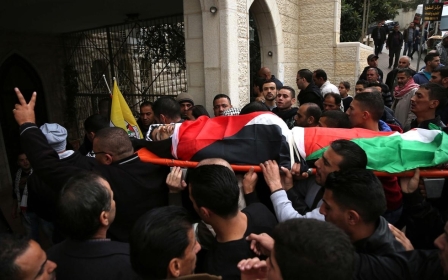VIDEO: Undercover Israeli agents seize protester in Bethlehem clashes

BETHLEHEM, West Bank - Abdelraham Hassan, 23, was at the frontline of protests in Bethlehem on Friday when what looked like six Palestinian hooded protesters pulled out handguns and moved to grab the young men surrounding them.
It immediately became clear that the six men, wearing T-shirts and jeans with scarves and masks covering their faces, were in fact undercover Israeli agents, as uniformed Israeli security forces moved up the street and took up covering positions.
"It was really quiet around the time of the protest - [the Israeli soldiers] weren't shooting tear gas or bullets or anything," Hassan said. "There were around 30 guys at the front during the calm [period]. Then out of nowhere six of them pulled out guns and everyone ran."
Hassan was taking photos, not filming, when the chaos erupted. Before he could begin filming he said one the undercover agents came up to him and another journalist he was standing with and held a gun up to their heads, telling them to leave.
"He didn't have time to deal with us, and we kind of just felt like we weren't their mission. They were there to arrest the protesters, and they already had one on the ground, so I just started filming," Hassan said. "But it was terrifying: we know that these guys, undercover agents, have orders that allow them to shoot to kill under any circumstances."
The undercover agents managed to detain one young man. Protesters initially thought they had caught three people, but the two others got away.
One of the young men who was almost detained struggled and managed to get away with a red scarf one of the agents had been wearing. Protesters passed the mundane-looking scarf around, the only tangible evidence of what had just happened on their street.
The incident is the second time in less than a month that Israeli forces have been caught on camera using undercover agents to capture Palestinian protesters.
In October, several journalists in the al-Bireh area of Ramallah in the occupied West Bank filmed Israeli forces arresting and shooting several young men during a raid. The video of the event quickly went viral.
Hassan said he hadn't seen an undercover raid like Friday's since the second intifada, when Israeli forces attacked and detained a classmate as he and Hassan made their way home from school together.
Israel is known to maintain a cadre of undercover police units, whose members are well versed in the Arabic language and local culture.
The word used by Palestinians to describe Israelis who infiltrate their communities, mustarabiin, means someone who is disguising themselves as an Arab.
At protests in which there are youths from a variety of neighbourhoods, it is common practice for protesters to tuck their shirts into their trousers and to question anyone not doing so. The point of the practice is to prove that you do not have a gun around your waistline.
Hassan said that young men in Bethlehem have already begun discussing different ways to stop Israeli forces from infiltrating protests again.
"The boys are saying they don't want anyone to wear anything on their faces now," He said. "[At the moment] they wear scarves to try to hide their identity so the Israelis don't detain them later. But now they're saying: 'Enough, if you're scared don't come.'"
Middle East Eye propose une couverture et une analyse indépendantes et incomparables du Moyen-Orient, de l’Afrique du Nord et d’autres régions du monde. Pour en savoir plus sur la reprise de ce contenu et les frais qui s’appliquent, veuillez remplir ce formulaire [en anglais]. Pour en savoir plus sur MEE, cliquez ici [en anglais].





